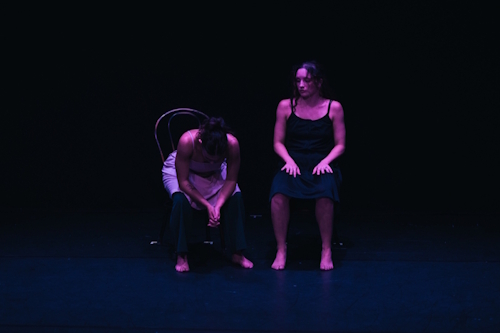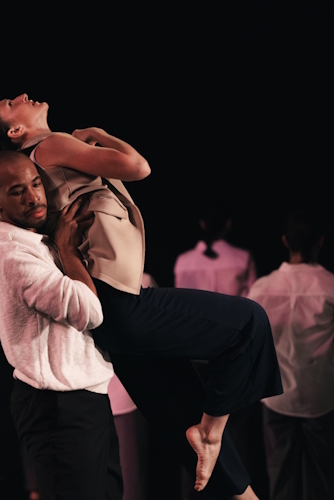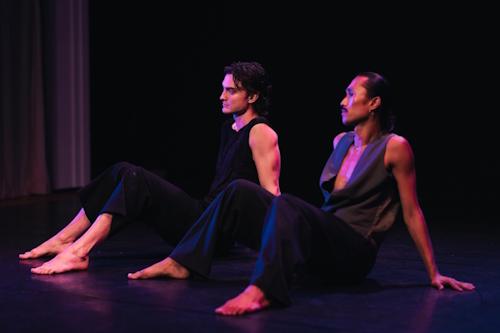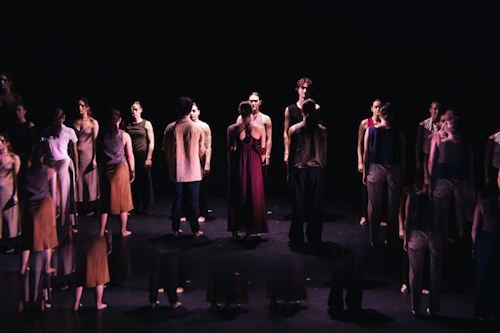3AM Theater, Astoria, Queens, New York
September 20, 2025
Dinner Party, directed, produced and choreographed by Michelle Thompson isn’t really about the titular gathering at all. Rather it’s an exploration of the relationships between five couples: the hosts and four pairings invited to the event in question. It is also an interdisciplinary work, Thompson working with SOCIETY, a collective of theatre makers based in the city, in particular Scott Illingworth (Director of Audio Performances) and Paige Housner (Dance and Script Associate).
The idea grew out of Thompson’s interest in the choreographic structure of the duet, with each of the couples visited in turn, each conversation heard in recorded text, seen in dance. They are a very true reflection of normal life, shifting between mundane and challenging topics and full of the quiet negotiations that happen everyday, as individuals reveal their personal baggage, struggles, doubts and insecurities. Time and again, I found myself reading between the lines.

in Dinner Party by Michelle Thompson and SOCIETY
Photo Layla Shoo
As can often happen, especially when under stress, little things become big things. The first scene sees us meet Monica and Paule (Sam Assemany and Brandon Coleman), the dinner party’s hosts. Having walked into the kitchen to find her listening to opera as she prepares the salad, an innocent remark about not knowing she liked opera is met by a snappy “Well, You never asked.” While the couple were clearly very much in love, you could feel the temperature drop for a while as things took on an ‘edge.’

in Dinner Party by Michelle Thompson and SOCIETY
Photo Layla Shoo
Here, as elsewhere, the spoken conversation is not mimed. Rather, the dance lends emphasis to the words rather than imitating them. The whole cast, many of whom have performed previously with well-known companies, were excellent. The partnering was exceptionally good.
I did find the text rather quick fire on the whole. Is that a personal thing, a cultural thing, or even both? I’m not sure. While there were moments of stillness, I felt maybe there could have been more. As in any art form, the silences, the blank spaces, so often speak loudest.

in Dinner Party by Michelle Thompson and SOCIETY
Photo Layla Shoo
Among the conversations are more ‘out and out’ dance episodes, which allow to little breathers. One such comes when Paule runs an errand to pick up a cake that Monica forgot. The choreography, for him and an ensemble of seven, who I presume were bakers, flowed nicely.
There’s more edginess between the second couple, Marnie and Cleo (Liz Hepp and Jamie Kleinschnitz), with one upset because the other took time to have an after-work drink with colleague Chelsea, “Who’s having a hard time.” That opens up a whole bottle of issues that one suspects has been bubbling away for some time, revealing the metaphorical tightrope the relationship seems to be on.
When we find Elaine and Jeremy (Alexis Borth and Quaba Venza Ernest) in a restaurant, all is not well. “Do you not want to go to the party?” “I don’t know what I want.” Vulnerabilities are laid very bare as she reveals she has been warned about the possible onset of dementia, as one is so tempted to do, fearing and seeing the worst. “Do you want to go home?” he asks. “I just want to get drunk.” You feel. You really feel.
Each scene brings something different. Alex and Sage (Thomas Hogan and Carl Ponce Cubero), and Quinn and Michael (Beatriz Castro and Jacob Glendenning) appear side-by-side, sort of split-screen, the action flitting smoothly from one couple to the other. It turns out Alex, Paule’s brother, hasn’t been quite fully open with him. “I told them I was bringing someone. They’re OK with it,” he says. “But you promise? They know I’m coming? Replies Sage. “I told them I was bringing someone, yeah,” responds Alex, telling us everything we need to know without quite saying it.

in Dinner Party by Michelle Thompson and SOCIETY
Photo Layla Shoo
The storylines collide when the couples all find themselves in the same room at the dinner party. Except that we don’t really see that. Instead, Thompson gathers everyone, couples and supporting dancers) on stage in a very busy ensemble section that unfortunately the main characters get rather lost.
I also found the Prologue the greeted the audience as they arrived at the intimate 3AM Theater in Astoria, Queens, situated on the top floor of what used to be a cigar factory, somewhat unnecessary.
While I may have doubts here and there, let’s say it loud and clear: Dinner Party was an entertaining and engaging hour, a seamless coming together of text and movement, playwriting and choreography. Just how impressive, how believable the characterisations were, was shown by the fact I walked away wondering what happened next, imagining the conversations that might have happened on the way home. Indeed, in many ways, I’d rather have much rather somehow skipped the party scene and seen that instead.
At the end, Thompson thanked various people for allowing her to pursue her “crazy idea.” Not so. In fact, a rather inspired, and well-realised one.


